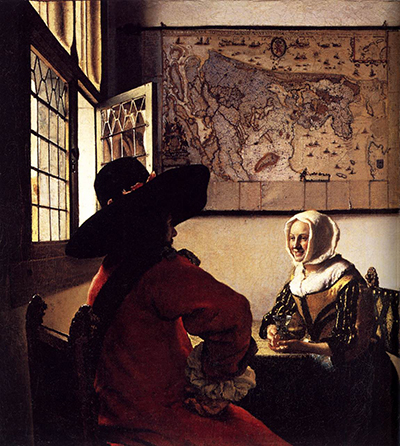The brilliant painting is the creation of Dutch artist, Johannes Vermeer, as he incorporates a masterful technique to showcase exquisite detail and colour.
The oil on canvas artwork dates back to 1657 near the beginning of the artist's career portraying the lifestyle of the 17th century.
The artwork holds an array of the artist's classic characteristics, including a realist technique that reveals intercut detail throughout the artwork.
The focal point of the artwork is seized by the woman dressed in yellow seated in the hair with her hair covered in a yellow cloak. The woman's face is tilted to the side towards a light source that is a window, brightening her face. The woman's Dutch features are revealed through her face as her rounded pale face is met with the light.
The woman is seated at a table directly across from a man dressed in red with a large dark top hat. The man melts into the darkness of the painting as his dark figure sinks into the frame taking away colour.
Yet, the viewer is able to make out that the man is dressed in a deep red colour, with white ruffled sleeves. The man's large black hat covers his face while adding a mysterious look to the individual. The man gently tilts his hand against his knee and looks towards the woman as both face one another.
Vermeer was well known for using very neutral colours throughout his work. The canvas is filled in shades of whites and darks, adding a glimpse of colour through the man's red suit and the woman's yellow dress. Vermeer was believed to be inspired by artist Gerard Van Honthorst.
Art critics have suspected that Vermeer had used a camera obscure to capture the layout of the painting. By using this element, the artist was able to gain a better perspective instead of focusing on a focal point. This idea has been argued through the position of the woman within the frame, as she is flattened out against the surface.
The woman within the painting is believed to have resembled Vermeer's wife Catharina, who is believed to have posed for an array of the artist's paintings. With x-ray photographs, art historians are able to tell that the artist planned to paint the woman with a large white collar yet had changed his mind.
Both the man and the woman within the painting significantly resemble the characters within another painting, The Procuress. Within both artworks a woman in a light yellow dress is seated smiling while a man in red and a large black hat works to capture her attention.
The man within the painting is said to be a cavalier wearing an incredibly expensive hat with a beaver pelt. The red suit in which the man is dressed in is meant to be associated with power and passion, adding drama and a greater mysterious mood to the piece. The artist Caravaggio often used the technique of using specific colours to add to the emotion within the artwork.
The window in the top left section of the artwork is as well associated to the classic style of Vermeer as the artist corresponds the placement of the window in relation to adding light to the painting.
The use of a window is evident in the other paintings Girl Reading a Letter at an Open Window, and The Milkmaid. These artworks are structured around the location of the window as the artist has to strategically place a light source to illuminate the focal points within his work.




